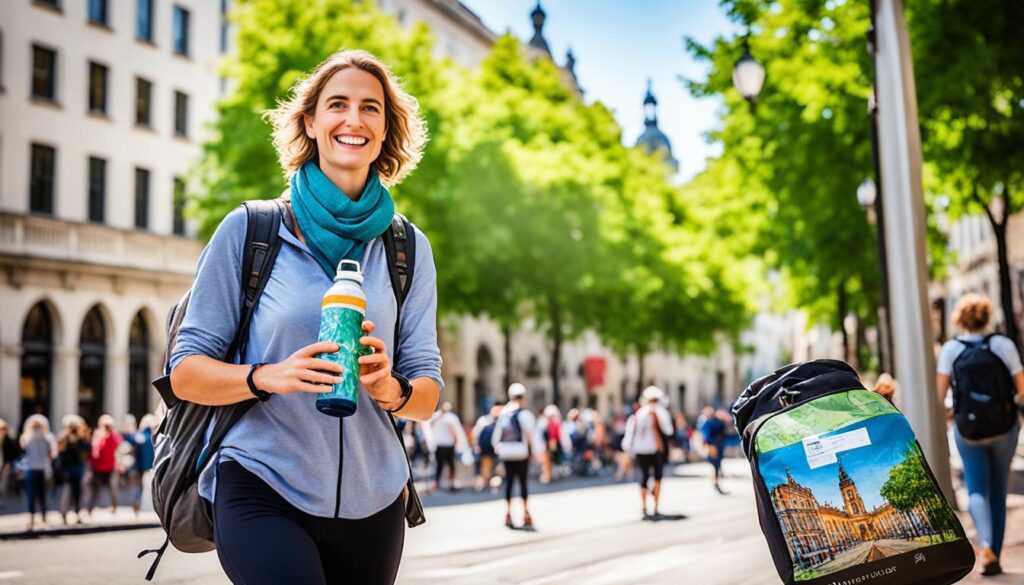Start a journey through historic cities, where every stone and building tells a story. This guide is packed with travel advice for your trip. It’s perfect for anyone looking to explore or just take a vacation.
Learn how to find hidden gems and dive deep into the culture. This article will show you how to make your trip unforgettable. You’ll discover the secrets of historic cities and see amazing sightseeing spots.
This guide is your key to exploring urban exploration. It gives you tips and strategies for planning your trip. Get ready to fall in love with the beauty and history of these amazing places.
Unraveling the Secrets of Historic Cities
Exploring historic cities is a journey that lets you dive deep into local culture and find hidden spots. You’ll walk on cobblestone streets in old European cities and explore vibrant neighborhoods in cities with a long history. These places offer many authentic experiences that take you back in time.
Immersing Yourself in Local Culture
To really feel the vibe of a historic city, you need to dive into its culture. Look for ways to meet locals, like going to a traditional festival, visiting a small artisan shop, or just chatting with someone who lives there. These moments let you learn about the place and its traditions that have lasted for years.
Uncovering Hidden Gems
Historic cities often have secret spots that aren’t on the main tourist paths. Go into areas not many people visit, see sites that aren’t well-known, and soak up the special feel of each area. These spots give you a real, deep look at the city and its history.
By getting to know the local culture and finding hidden spots, you start a journey beyond the usual tourist path. Get ready to be amazed by the mix of traditions, customs, and stories that make each place special.
Essential Packing for Urban Exploration
Starting an adventure in historic cities means packing smart. You’ll need the right gear for cobblestone streets and hidden spots. Focus on packing for comfort, versatility, and practicality for a smooth trip.
For packing tips in historic cities, comfort is key. Choose a good pair of travel essentials like walking shoes that support your feet well. Pick clothes that breathe and keep you dry during your urban exploration. Always pack layers for the changing weather in these cities.
For historic city travel, a minimalist packing approach works best. Use a few key pieces that you can mix and match. Include items like a light scarf or a compact rain jacket to be ready for any weather.
With essential, versatile items, you can move easily through the city. This way, you’ll have space for the surprises and local finds along the way.
Travel: Navigating Historic Cities with Ease
Exploring historic cities is rewarding but can be tough. Luckily, there are easy and green ways to see these places. You can learn about public transport and enjoy walking tours.
Mastering Public Transportation
Public transport is often the best way to move around historic cities. It’s easy on the wallet and convenient. Learn about the metro or bus systems before you go. Check out schedules and ticket info early.

Walking Tours: A Pedestrian’s Paradise
Walking is a great way to feel the vibe of a historic city. Walking tours let you see hidden spots and get to know local areas up close. You’ll hear stories and see things you might miss otherwise.
Choose guided tours with experts or make your own path. Either way, walking lets you enjoy the city’s beauty at your pace.
Using local ways to get around makes your trip better. It connects you to the city’s heart and soul.
Capturing Unforgettable Moments
Make your historic city trip last forever with your camera. As a travel photographer, you can save the essence of your destination. From beautiful buildings to lively streets, your photos tell stories that take viewers right to the heart of the city.
Photography Tips for Historic Cityscapes
To get the perfect shot in a historic city, you need an eye for detail and knowledge of what makes it special. Look for unique buildings with beautiful designs, tall towers, and small details. Use your camera to show these off in a way that makes them look timeless and important.
Street photography lets you see the city’s life up close. Find busy markets, big squares, and hidden spots to dive into the city’s culture. Look for moments that show feelings, surprises, and the real vibe of the place.
Also, notice how light and shadow work together. Historic cities have a mix of natural and man-made light that creates interesting scenes. Try different camera settings to catch the city’s unique feel and make your photos timeless.
With your photography skills, you can keep your historic city trip alive for others to see. These photos are not just for you; they can inspire others to visit these amazing places. They help keep the memories of your trip alive and make a big impact.
Savoring Local Flavors
Exploring historic cities is a great way to dive into the local culture. The food scene is a key part of this experience. By trying local dishes, you learn about the area’s history, traditions, and identity.
While walking through historic streets, find authentic places to eat. Look for family-run spots, busy markets, and small cafes with long histories. These places serve dishes that have been loved for generations.
Join food tours, cooking classes, or hands-on activities to learn more about the city’s food. These experiences let you meet local chefs and farmers. You’ll learn the secrets of the flavors that make the place special.
Trying a hearty stew, a rich dessert, or a local drink takes you straight to the city’s culinary heart. Each taste is a journey into the local culture.
Enjoying local food is a great way to connect with the community. Supporting local food makers and traditions helps you appreciate the area’s heritage. You’ll also feel closer to the people who make these flavors possible.
Sustainable Travel in Historic Cities
Exploring historic cities means embracing sustainable travel. By choosing eco-friendly habits, you make a positive impact. This way, you travel responsibly and with care.
We’ll share tips for sustainable travel in historic cities. These tips help you enjoy your trips while protecting the environment.
Eco-Friendly Practices for Conscious Explorers
Start with conscious choices for sustainable travel. Use public transport, walk, or cycle in historic cities to cut down on carbon emissions. Support local shops and artists to help the community and preserve historic areas.
Carry a reusable water bottle and bag to reduce waste. Always throw away trash properly.
Choose to stay in places that care for the planet, like eco-lodges or green hotels. These places use less energy, save water, and help local communities. This way, you enjoy your stay without harming the environment.
Learn about the history and culture of where you visit. Be respectful of historic sites and local people. Avoid damaging these places and interact with locals with respect and care. This helps protect these places for others in the future.
Sustainable travel is more than just being green. It’s about connecting deeply with the places you visit. By being eco-friendly, you become a thoughtful traveler. You create positive experiences that benefit both you and the communities you visit.

Celebrating Cultural Diversity
Exploring historic cities is more than just looking at old buildings or learning about their past. It’s a chance to celebrate the rich cultural diversity that makes these places special. By engaging with local traditions, travelers can gain a deeper understanding and appreciation for the unique culture of these cities.
Respecting Local Traditions
When you visit historic cities, it’s important to keep an open mind and a willingness to learn. Do some research to understand the importance of different cultural practices, festivals, and rituals. This makes your trip more meaningful and shows respect for the local culture.
Don’t assume things or make judgments. Instead, dive into the rich traditions that make each city unique. This approach helps you connect with locals and creates lasting memories. It also deepens your understanding of the cultural diversity in these places.
Being inclusive and respectful is key to a memorable trip. It opens doors to meaningful connections with the people you meet. This way, you get to experience the true essence of the cultural diversity in historic cities.
Connecting with the Past
Exploring historic cities is more than just looking at old buildings and landmarks. It’s a chance to connect deeply with the past. You can learn about the people, events, and stories that made these cities what they are today. This journey can change you and make you see things in a new way.
One way to feel the past is by finding hidden spots that show the city’s true heart. Look for local landmarks, museums, and sites that tell the stories of everyday people. Talk to guides or go on tours that make history come alive, mixing it with your own experiences.
Walking through old streets and looking at the architecture can make you feel like you’ve stepped back in time. Let the stories from old buildings and the sounds of footsteps from the past touch you. By diving into the culture of these cities, you’ll feel closer to their history and appreciate their strength.
Trying new things in historic cities helps you connect with the past too. Join workshops, taste local foods, or learn traditional arts. These activities deepen your understanding of the culture and help you feel a personal link to the city’s traditions.
Inspiring Historic Destinations Around the World
Start a journey through time and explore the world’s most inspiring historic spots. Visit ancient Rome or vibrant Havana to dive into human history. These cities are gateways to culture and understanding our past.
Travel back in time in Florence, Italy. Its streets and alleys are filled with Renaissance art. See the famous Piazza del Duomo, the Basilica di Santa Croce, and the Uffizi Gallery.
Then, go to Cartagena, Colombia, a UNESCO World Heritage Site. It mixes Spanish colonial architecture with Caribbean vibes. Walk the walled city, try local food, and enjoy salsa and cumbia music.






